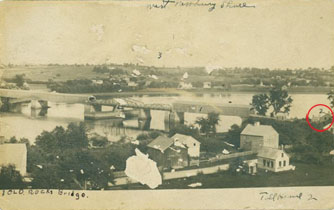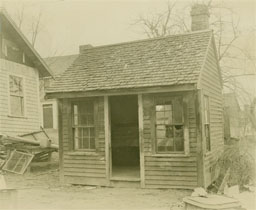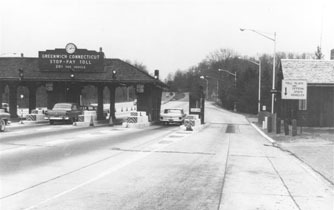| |
The Rocks Village Toll House
The 1828 Rocks Village Toll House is a simple, functional building made to house the toll keeper, and provide room for his other work as a shoemaker. The Rocks Village Toll House, which now sits adjacent to the Ackley Covered Bridge in Greenfield Village, formerly served a much larger covered bridge and drawbridge which spanned the Merrimack River, connecting the towns of Haverhill and West Newbury, Massachusetts. The bridge and toll house were built in 1828 to replace an earlier bridge that had been destroyed by a flood. Their construction was not the responsibility of the towns where they were located, nor the state or federal government, but of the Proprietors of the Merrimack Bridge, a group of Haverhill and West Newbury investors who had built the first Merrimack Bridge in 1795. The building housed a toll keeper, who was responsible for collecting the tolls and for opening the drawbridge when necessary. In his considerable spare time, the toll keeper also worked as a cobbler, making shoes. Tolls were collected until 1868, and the toll house remained in use for the drawbridge until 1912.
When the first Merrimack Bridge was built at Rocks Village in 1795, there was a need for good routes from the farmlands of northern Massachusetts and New Hampshire to the growing urban markets of Boston. Neither the new federal or state governments had the resources to build and maintain many roads. As a result, privately-owned turnpike and bridge companies, like the Proprietors of the Merrimack Bridge, were encouraged to fill that need with toll roads and bridges, and they proliferated around the new nation. The era of turnpikes and toll bridges was beginning to draw to a close when the second Merrimack Bridge was built in 1828. By mid-century, canals, and then railroads, had replaced roads as the primary means of traveling across distances, so roads and bridges were generally used more for local travel. This change can be seen in the decline in weekly receipts at the Rocks Village Toll House, from a high of $58 in 1857, to $29 in 1868, when the Merrimack Bridge became a free bridge. At that time, Essex County assumed authority over the bridge, and the towns it served, Haverhill, West Newbury, and Amesbury, shared the costs of its upkeep. With only local support, upkeep was sporadic at best, and by 1912, most of the bridge had to be replaced. The Rocks Village Toll House had witnessed the decline of the American road during the mid-19th century. It would not be until the advent of the bicycle in the late 19th century, followed by the automobile in the early 20th century, that this decline would be reversed.
The Merritt Parkway Tollbooth
The rustic design of the circa 1950 Merritt Parkway Tollbooth celebrated the pleasures of driving as a way to experience the outdoors, and was part of a larger effort to promote tourism in Connecticut. The Merritt Parkway Tollbooth was built in Greenwich, Connecticut around 1950, as an expansion to the existing toll plaza. The Merritt Parkway runs 37 ½ miles from the New York state line at Greenwich to Milford, Connecticut. It was built in 1938 by the State of Connecticut in order to relieve the congestion on US 1 (the Boston Post Road), the main route from New York to Boston. Tolls were collected on the Merritt Parkway until 1988.
The Merritt Parkway is, in many ways, a celebration of the revival of the American road. And, as a state response to local problems, it reflects the change in the responsibility for roads from the local to the regional and state level. Heavy New York-to-Boston through-traffic, in addition to commuter traffic in and out of New York City, had turned US 1 into a permanent traffic jam. This created tremendous problems for the local communities along that route. However, the citizens of those communities were not inclined to bear the financial burden of road improvement, especially since most of the people being served by any improvement were from out-of-state. The debate about how to solve this problem lasted from the early 1920s into the 1930s. The eventual solution contained the main elements of the modern highway. First, it bypassed the population centers, so that it pulled traffic away from busy downtown areas. Second, since it passed through the rapidly gentrifying farm and wood lands of southwest Connecticut, the design of the parkway emphasized the rustic beauty of the region through the graceful layout of the road through the rolling hills, as well as in the design of road’s bridges, service buildings, and, of course, tollbooths. The design made the road beautiful, and helped to promote Connecticut as a tourist destination for out-of-state visitors. Third, it was built during the economic depression of the 1930s, so its construction was promoted as a job-creating project. Finally, its construction and maintenance was funded by the state, and paid for out of the general treasury. The tollbooths were added after a couple of years to raise money for an extension of the highway to Hartford, Connecticut—the Wilbur Cross Parkway.
With the Merritt Parkway and similar roads, good public roads had returned and—for better or worse—had come to be viewed as an entitlement, subsidized through the public treasury rather than private investment.
-- Jim McCabe, Curator of Historic Buildings

|
 |
| This worn image of the Merrimack Bridge and the Rocks Village Toll House dates from between 1891 and 1912. It shows the 1828 covered bridge and toll house (marked #2) along the approach to the right of the bridge. |
The Rocks Village Toll House had been moved, and was being used as a tool shed when Henry Ford acquired the building in 1928. |
| |
|
 |
|
This image from the 1960s shows the Merritt Parkway tollbooth in use, next to the original rustic 1940 toll plaza. |
|
|

